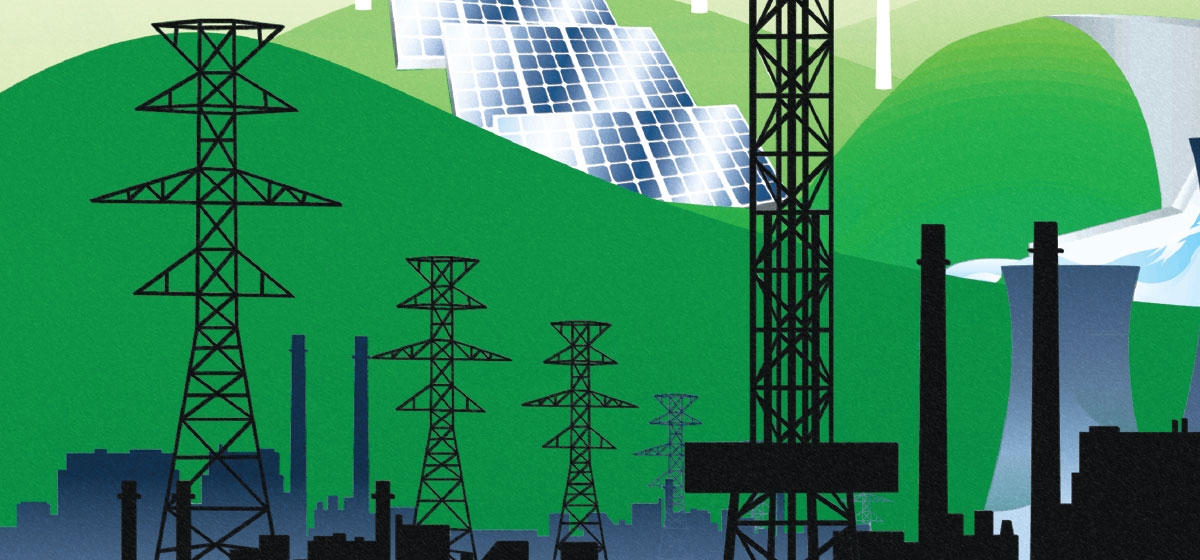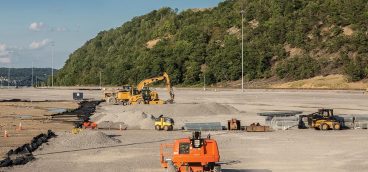The Marcellus Shale Dilemma

A blistering July—the hottest on record—vaporized heat records in thousands of communities across the country. A historic and prolonged drought settled across a vast swath of the southern and central United States, devastating corn crops and threatening to send the cost of everything that depends on it—from baby food to burgers to the ethanol we burn in our cars—skyrocketing over the next eight or nine months. And though the nation remains deeply divided over the issue, there were signs that a significant number of Americans were beginning to rethink their position on global climate change—and the role our dependency on fossil fuels, especially natural gas—plays in it.
And yet, despite the deep political and cultural divisions that remain over the issue, despite the deep ambivalence of the American people, and despite the absence of any significant policy initiatives from the state or federal governments, the country has, over the past five years, measurably reduced its carbon output. In fact, according to the U.S. Energy Information Agency, the total U.S. carbon emissions from energy demand dropped in the first three months of this year to their lowest levels in 20 years. Between 2010 and 2011 alone, the U.S. carbon output from energy demand declined by 2.4 percent, the EIA reported.
There are a number of reasons for that precipitous drop. An unusually warm winter across much of the country depressed demand for heating oil and gas. Increased fuel efficiency in cars and trucks reduced demand for oil, analysts say. The sluggish economy also played a role: Despite modest growth of between 1 and 2 percent, demand for electricity has remained more or less flat since 2007, according to the International Energy Agency, an autonomous body with 28 member countries.
And the growth of renewable sources of energy also has played a role. As an overall percentage of American energy consumption, renewables have declined by about 2.4 percent since a record 14 percent increase in 2011, but much of that small reduction came from a decline in the amount of hydropower the nation produces. The 2011 record for hydropower was largely due to near-record rainfalls in parts of the country that weren’t crippled by drought and has since contracted by about 13 percent to near-average historical levels this year.
And while wind still produces a comparatively small fraction of the energy we consume, its share of the U.S. market increased by 26 percent in the past year alone and is expected to increase another 17 percent next year. Solar energy nearly doubled over the past few years, according to the EIA. Overall, the EIA projects that all non-hydropower renewables will increase their market share of our total energy consumption by about 5 percent next year.
“Just to put that into perspective,” said Laszlo Varro, head of the Gas, Coal and Power Markets Division of the International Energy Agency, “the increase in renewable energy in the United States in the past six or seven years is around one and a half times larger than the [total] wind and solar production of Germany,” a country considered a leader in renewable energy.
But all of those factors pale in comparison to the one key element that has contributed to the decline in U.S. carbon emissions, say Varro and other experts—the sudden emergence of vast amounts of natural gas from shales like the Marcellus—which, when burned, produces between a third and half as much carbon as coal and about a third less than oil.
“In the past five years there’s little doubt that gas… was the single most important factor in bringing down carbon dioxide emissions,” Varro said.
As drilling in the Marcellus and other shales expanded exponentially in the past several years, driving down prices, gas has increasingly displaced coal as the fuel of choice for electrical generation. The amount of U.S. energy generated by coal has decreased by a quarter, while gas has increased its market share by half. In fact, Varro says, coal consumption in the U.S. electrical energy sector has decreased by an amount equal to the entire electrical production of a “medium-sized European country, like England.”
And yet, he and others acknowledge, as the world’s geographic poles thaw, the political poles seem to have thickened and expanded, with Pennsylvanians and all Americans becoming increasingly divided over the whole idea of fracking for natural gas and its benefits and risks. A recent survey conducted by PittsburghTODAY, for example, found that more than 70 percent of people in the 32-county Pittsburgh region said they believe that the Marcellus presented at least a moderate economic opportunity, while nearly 80 percent said that they see the development as at least a slight threat to the environment and public health, with 45.2 percent classifying the threat as moderate or significant. The study also mirrored the findings of polls that found that opposition to the development of the Marcellus tends to be stronger in areas farther removed from the most active fields.
That public ambivalence indicates how reports of the potential benefits of the natural gas boom have been tempered by deep concerns about the environmental consequences of the combination of horizontal drilling and high-volume hydraulic fracturing used to extract the gas. The concerns have been fueled by a series of high-profile accidents, including surface water contamination from spills and subterranean contamination of aquifers by methane, events that have been highlighted by an increasingly vocal and organized anti-fracking movement. Those voices have been stoked by what even the industry acknowledges is its history of seeming to be less than transparent with the public.
It also reflects grave concerns over the long-term impact of the amount of fossil fuel required simply to extract and process the natural gas, fuel that in many cases is still far dirtier than the gas itself, and over the release of methane throughout the process, a gas that while it remains in the atmosphere a far shorter time than CO2, is a far more virulent greenhouse gas while it’s up there.
There are also concerns that increasing reliance on natural gas will undermine efforts to develop renewable forms of energy. The concern from many in the environmental community is, as New York Times columnist Thomas Friedman put it in a column last summer, that wholesale extraction of natural gas will “undermine new investments in wind, solar, nuclear and energy efficiency systems—which have zero emissions—and thus keep us addicted to fossil fuels for decades.”
Those concerns have certainly drawn the battle lines between two highly partisan and highly motivated camps—camps that have become almost mirror images of each other, according to former Pennsylvania Department of Environmental Protection Secretary John Hanger. “The hardcore who just want to ban the industry are never going to stop saying ‘nay’… they’re like the hardcore climate deniers. New York could be under water. The hardcore really is beyond reason,” said Hanger.
That’s a sentiment shared by John Quigley, the former head of Pennsylvania’s Department of Conservation and Natural Resources under the Rendell administration, who now lectures extensively on the natural gas boom. “On the left you have the moratorium crowd, the Alec Baldwins and the Josh Foxes of the world, that want to demonize gas,” he said. ” ‘The evil fossil fuel companies are out to kill us and rake in profits,’ and that’s just… cartoon villainy,” he said. On the other side, he said, industry strains credibility, depicting itself as intrepid cowboys riding alone on America’s energy frontier. They try to sell themselves as “rough and ready, plucky entrepreneur[s],” he said. “Scratch any of them and they’re right-wingers.”
The two sides, he says, are in danger of becoming so intractable that whatever advantages natural gas could offer in terms of reducing our reliance on foreign fuel sources and our dependence on coal could easily be reversed. With the two sides locked in a stalemate, he says, there is a toxic political atmosphere.
One of the results is that there has been little leadership on a state or federal level on either the environmental or economic challenges that natural gas development presents. The reduction in CO2 emissions that has come from switching electrical power plants from coal to gas, for example, has happened almost entirely as a result of market forces. The problem is, he says, “this reduction in CO2 is illusory… because it’s driven by Adam Smith’s invisible hand, and that’s going to go away. It’s temporary unless we take the bull by the horns and make something happen.
“There’s a reduction in emissions, everybody feels good, but it’s not a lock that this is going to last. Part of the reduction is the weather—the warm winter and the significant drop in the use of oil that was driven by efficiency and a lot of other things. So it’s not just gas. Gas is probably one of the most significant things, but it was the combination that resulted in our emissions reductions, and anybody who thinks that they’ve reached the happy point where Adam Smith is going to lead us away from climate change, it isn’t going to happen,” Quigley said.
“We need for the first time in the history of this country a conscious energy policy that is more than aircraft carriers in the Persian Gulf,” he said. “Without a conscious national energy policy that takes advantage of natural gas and drives alternative energy on the back of gas, and… uses the political muscle of the gas industry to drive this, we’re swinging and missing.”
There is, says Hanger, a dire need for less strident voices in the debate and room for the kind of consensus that could help build the political will to propel that kind of policy. “There are a lot of people who are not the hardcore but are influenced by these concerns. They’re good people, and they hear, for example, that gas is as dirty as coal or that gas is as bad as coal. They’re not experts; they care about climate,” Hanger said. “For those folks, I think already the information that is coming out has begun to cause them to rethink their opposition.”
There are others, he says, who are influenced by the debate they hear; they catch snippets of the conversation that suggest that there’s a danger but they also hear that there may be advantages.
Increasingly, there are signs that less strident voices are beginning to elbow their way into the public discourse. In August, billionaire businessman, philanthropist and New York City Mayor Michael Bloomberg, along with George P. Mitchell, the Texas driller whose company launched the shale gas boom at the end of the last century, penned an opinion piece for the Washington Post that argued that “fracking for natural gas can be as good for our environment as it is for our economy and our wallets, but only if done responsibly,” while they criticized the industry for attempting to “gloss over” what they described as “legitimate concerns about its impact on water, air and climate.”
Bloomberg followed that up with a $6 million grant to the Environmental Defense Fund, an organization that, according to its Vice President for Energy Jim Marston, believes “there are potentially large benefits to natural gas but only if done right, and in many places, production, storage and transportation of natural gas is not being done right.” According to a press release announcing the Bloomberg grant, it will be used to study ways to “minimize the environmental impacts of natural gas operations through hydraulic fracturing.”
Among other things, some of that money will go toward funding a study to quantify the greenhouse effect from methane released into the atmosphere through the entire life cycle of natural gas production and consumption, Marston said.
Bloomberg’s foray into the great debate included a call for increased government regulation on state and federal levels over five aspects of the operation: demanding greater disclosure of chemicals used in the process; tighter standards for well construction and operation; greater regulation of water consumption and disposal; plans to limit the negative impact of development on roads, communities and the environment; and a greater focus on air pollution issues, not just regarding fugitive methane, but also with regard to the amount of other fossil fuels used in the life cycle of natural gas.
And it came on the heels of an exceedingly blunt statement at a speech in Houston, Texas, last summer from IEA Executive Director Maria van der Hoeven, in which she argued that while natural gas expansion in the power sector “has caused emissions to fall rapidly,” concerns about the risks are real, and the industry in many places around the world has been lax about acknowledging their failures and responding to them. If the industry continues to fail in that regard, she warned, “There is a very real possibility that public opposition to drilling for shale gas will stop the unconventional gas revolution and fracking in its tracks.”
There are signs that at least some in the industry are beginning to hear the warnings coming from people like Hoeven, Quigley and Hanger.
“What matters now is engagement,” said Andrew Price, corporate director for energy and environmental policy at EQT, one of the state’s most active natural gas drillers, and a former deputy secretary for energy deployment at the DEP. “You need to get in a room with people… in the rational middle that are not throwing mortars at each other in both directions,” he says.
To be sure, he says, “we cannot escape the fact that affordable energy is essential to our economy. Once you understand that, then you look at ‘here are all the pros and cons across the board, impacts, benefits, costs, what’s the timeline for implementing renewables’ and so on. Then you can have a robust discussion.”
But the industry, he says, must also come to terms with the fact that it has to work to reduce its impact, and that, he said, is going to require a recognition that increased governmental oversight is probably inevitable. “You have to embrace regulation,” he said.
That is precisely the message that the IEA has been trying to get across, said Varro, in an interview with Pittsburgh Quarterly from his office in Paris. “Overall, we are optimistic about the… gas potential of the United States. If the U.S. shale revolution continues, then the U.S. upstream has the capacity to increase gas production at reasonable gas prices.” And even if the Invisible Hand pulls a card out of its sleeve and gas prices rise moderately, the cost of construction of new coal plants, coupled with regulatory uncertainty, make it probable that gas will continue to supplant coal as a fuel source for power generation. That, he says, means fewer greenhouse emissions.
“But what if you have a political backlash, a ban on hydrofracking, let’s say? In that case, the U.S. goes back to importing expensive energy from South America and the Middle East. In that case, U.S. gas prices go high again. And the U.S. will again face national security concerns.”
The IEA, he says, has determined that, “the biggest noncommercial gas production will be in three countries, the United States, China and Australia, which are also rich in coal. Our prediction is that if we have a backlash against natural gas, like a ban on hydrofracturing or something like it, then 75 percent of that lost natural gas will be replaced not by other gas sources, but by coal,” Varro said. “In that case, we lose the advantage.”
The IEA, he said, takes the position that “banning fracking and rolling back shale gas would be a really bad thing. It’s somewhat ironic that environmentalists are not behind this. We also concluded that their concerns are absolutely legitimate. The usual natural gas industry talking point is that there’s nothing to worry about, we are the experts, we know best. But we didn’t buy it.”
“So on one hand we told the environmentalists that if you care about the environment you have to learn to love hydrofracking. And on the other hand, we also told the industry that you have to get your act together.”





